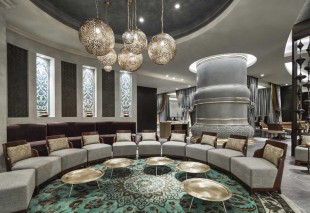

Design case study: Fairmont Ajman

Ajman may be the smallest of the seven emirates in the UAE but its untouched beaches are attracting hotel operators from around the world. Great importance has been placed by the Ajman Tourism Development Department on supporting the growth of Ajman as a tourist destination while preserving its cultural heritage. Kempinski, Marriott International, Starwood Hotels & Resorts and the recently opened Fairmont hotel are all contributing to Ajman’s tourism landscape.
With an exterior in Arabic style and its sleek and contemporary interior, designed by the interior design consultants Godwin Austen Johnson (GAJ), Fairmont has elevated the benchmark for luxury five-star hotels and resorts in this area. According to GAJ, the client’s brief for the interior was simple — they wanted an elegant hotel that offers its guests a modern day interpretation of the rich Arabian heritage.
“Ajman is renowned for its strong maritime trade and fishing heritage along with its laid back pace, and in keeping with its locality, we developed a concept that would seamlessly juxtapose these local traditional elements with fresh contemporary interiors. They wanted a hotel that would become a landmark for Ajman and there were certain guidelines we needed to follow. During the design process we worked very closely with Fairmont operators to better understand them as a brand,” says Jacinda Raniolo, who has been GAJ’s lead interior designer for various hospitality projects.
The traditional geometric patterns found in Arabian architecture is a consistent theme throughout hotels and resorts in the Middle East. Reference to this traditional style has been introduced throughout the Fairmont where textured patterns are applied.
“By deconstructing the traditional geometry and morphing it, we took on the challenge to offer Fairmont something different with a contemporary twist. We tried to maintain the overall theme for the main areas such as the Cigar Lounge bar and reception desks, but this theme is evident in the design of decorative screens and floor patterns,” says Hilda Impey, GAJ’s designer specialising in furniture, fixtures and equipment.
The hotel itself has a refined and sophisticated feel throughout. The dark wood panelling set against a neutral palette lends itself to the calming ambience and contemporary feel. It also offers an elegant canvas upon which designers introduced bold accent colours such as azure, ruby and amber.
Impey adds: “These colours were derived from local influences, namely the fishing, jewellery and maritime trade. However, we searched for inspiration in a more abstract way by referring to basic elements of nature and raw materials. For example, the organic cross sections through the vibrant gemstones along with the jewellery inspired artwork were the ideal balance to the very masculine and structured design of the furniture. Ramesh Gallery was the local art consultant on this project and their understanding of the local heritage and the Fairmont brand was crucial to achieving such a successful result.”
Upon entry, guests are greeted by a double-height reception area and a thirteen level atrium space. A feature “folded” timber and bronze backdrop behind the concierge and reception desks acts as a curtain concealing the administration areas. The reception lobby and golden staircase are impressive in size and create a sense of grandeur.
An expansive lobby lounge is decorated with a glass beaded ceiling installation, which hangs as a tribute to the local fishing industry. This installation is enhanced by a bespoke carpet, manufactured by a local company called United Carpets, which together with the furnishings merge into the various blue shades of the Arabian sea.
The hotel offers eight F&B venues. Raniolo chooses all-day dining restaurant, the Spectrum, as her favourite.
“The design inspiration is derived from a ‘food market’ with a souk atmosphere, showcasing food in an artistic way. The buffet counters and islands are made from neutral beige stone material and are complemented by a splash of bright red octagonal glazed mosaics from Casa Mia. Materials are warm and rustic but detailed with a contemporary flare. Local influences are brought together with brass lanterns, upholstery, embroidery and handcrafts,” says Raniolo.
A private dining area has been designed as an intimate space for family and friends, utilising a decorative bronze chain curtain from Kriska Decor coupled with the backdrop of the glazed red mosaics and custom-made round pendants with an Arabic perforated pattern. The chain curtain is used in the space to provide privacy without separation from the vibrant atmosphere of the all-day dining area.
The warm colour palette for the signature Turkish restaurant was inspired by the spices of the region.
Impey adds: “The Turkish restaurant is my favourite and it’s quite theatrical. We did a lot of research about the Topkapi Sultan’s Palace in Istanbul and its vast culinary history. To create this unique environment, we mixed the rich style of the Palace and the Byzantine period with a contemporary flair.” Hand-painted Iznik tiles used as wall features are sourced directly from Turkey. Concrete tiles, also sourced from Turkey with an Arabic star pattern, were also used as a complementing wall feature to tone down the bright colours.
The concept behind the guest rooms was to use the colour scheme of natural elements and abstract beauty from Arabic jewellery, precious stones and intricate metal fretwork inspired by the local heritage. The guest rooms are divided into four colour schemes: Azurite and silver, rubies and antique copper, amber and light copper, and amethyst and gold. The colour scheme of the corridors is matched to that of the guest rooms. The designers wanted to create the feeling of entering an intimate and stylish zone as soon as guests step out of the elevator.
Throughout its 25 year history, GAJ has created buildings, such as Dubai Creek Golf Club, Bab Al Shams and the Arabian Court Residence & Spa at The One & Only Royal Mirage. Besides Raniolo and Impey, key people involved in the Fairmont project were Kevin McLachlan, head of interior design and senior interior designers Francisco Ongkiko and Jobeth Estabaya.